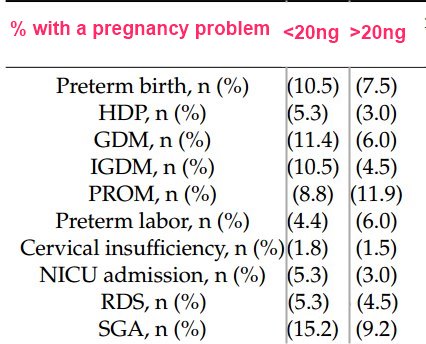Many pregnant women are deficient when taking the recommended amount of Vitamin D
Longitudinal Assessment of Serum 25-Hydroxyvitamin D Levels during Pregnancy and Postpartum—Are the Current Recommendations for Supplementation Sufficient?
Nutrients 2023, 15, 339. https:// doi.org/10.3390/nu15020339
Pilar Palmrich h*, Alexandra Thajer 2 , Nawa Schirwani 1 , Christina Haberl 1 , Harald Zeisler 1 , Robin Ristl 3 and Julia Binder1©
Department of Obstetrics and Feto-Maternal Medicine, Medical University of Vienna, 1090 Vienna, Austria
Division of Neonatology, Department of Pediatrics and Adolescent Medicine, Pediatric Intensive Care Medicine
Neuropediatrics, Comprehensive Center for Pediatrics, Medical University of Vienna, 1090 Vienna, Austria
Center for Medical Statistics, Informatics and Intelligent Systems, Medical University of Vienna, 1090 Vienna, Austria
- Correspondence: pilar.palmrich@meduniwien.ac.at

HDP (hypertensive disorders of pregnancy),
GDM (gestational diabetes mellitus),
IGDM (insulin-dependentgestational diabetes mellitus),
PROM (preterm rupture of membranes),
NICU (neonatal intensive care unit),
RDS (respiratory distress syndrome),
SGA (small for gestational age)
Background: Pregnant women are at risk of vitamin D deficiency. Data on pregnancy outcomes in women with vitamin D deficiency during pregnancy are controversial, and prospective longitudinal data on vitamin D deficiency with consistent definitions in pregnant women are scarce.
Methods: The aim of this prospective longitudinal cohort study was to investigate 25-hydroxyvitamin D levels over the course of pregnancy and postpartum in singleton and twin pregnancies with regard to dietary and supplemental vitamin D intake and environmental factors influencing vitamin D levels, evaluated by a standardized food frequency questionnaire.
Results: We included 198 healthy singleton and 51 twin pregnancies for analysis. A total of 967 study visits were performed over a 3-year period.
Overall,
59.5% of pregnant women were classified as vitamin D deficient in the first trimester,
54.8% in the second trimester,
58.5% in the third trimester,
66.9% at birth, and
60% 12 weeks postpartum,
even though 66.4% of the study population reported daily pregnancy vitamin intake containing vitamin D. Dietary vitamin D intake did not affect vitamin D levels significantly.
Conclusions: The majority of pregnant women evaluated in this study were vitamin D deficient, despite administration of pregnancy vitamins containing vitamin D. Individualized vitamin D assessment during pregnancy should be considered to ensure adequate supplementation and prevention of hypovitaminosis D.
Download the PDF from VitaminDWiki
This study considers <20 ng to be deficient. Everyone should have 40 ng. including before, during, and after pregnancy
VitaminDWiki - Pregnancy category contains
{include}
VitaminDWiki -Healthy pregnancies need lots of vitamin D contains
{include}
VitaminDWiki – Infant-Child category has items and contains
{include}
{include}
